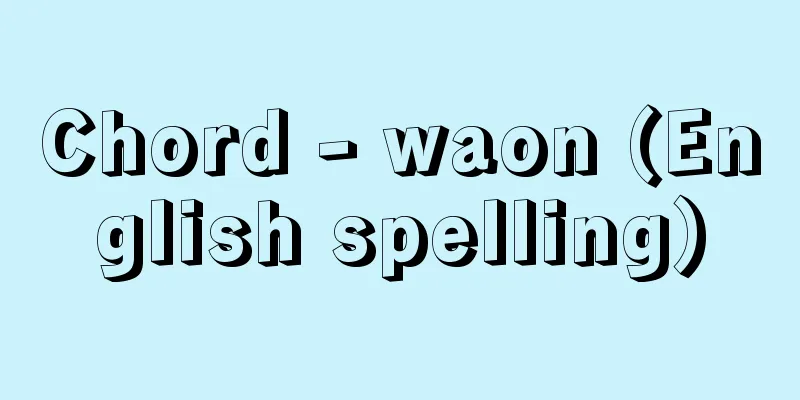Chord - waon (English spelling)

|
A musical term. Also called a chord. A composite sound that is produced when musical tones of different pitches are played simultaneously. Usually, three or more musical tones are required, and when there are only two, it is called an interval and is distinguished from a chord. However, although it originally had three tones, there are a few cases where one tone is omitted to make it two tones (for example, a hollow fifth chord that omits the E from the C-E-G chord). [Toshiaki Kurosaka] Types and classificationsChords can be made by selecting three or more different notes, so theoretically an infinite number of different types can be created, but in Western tonal music, certain rules are set for their selection. That is, notes that are a third apart are stacked on top of one another. For example, if C is used as the base note, then E, G, B, and so on must be stacked on top of it. In this case, several types of chords are created based on the pitch relationship between the base note (called the root note) and the stacked notes. A chord consisting of three notes is called a triad, and there are four types: major triad, minor triad, augmented triad, and diminished triad. A chord consisting of four notes is called a seventh chord because the interval between the root note and the fourth note is a seventh. There are five types of seventh chords, depending on the interval between the constituent notes: dominant seventh chord, major seventh chord, minor seventh chord, leading seventh chord, and diminished seventh chord. Chords consisting of five notes are called ninth chords, eleventh chords, and thirteenth chords, because the interval between the root note and the top note is a ninth, a sixth note is an eleventh, and a seventh note is a thirteenth. Because these chords have many constituent notes, the musical notes other than the root note, the second note (called the third note because it is three degrees above the root note), and the top note are often omitted. A chord that contains all of the constituent tones is called a perfect chord, and a chord that omits some of the constituent tones is called an imperfect chord. Chords made of stacked thirds can also be classified in a different way, namely, as consonant (or concord) or dissonant (or discord), depending on how the compound tones sound. Of all chords, major and minor triads belong to the former, while all other chords belong to the latter. [Toshiaki Kurosaka] nameChords are given names depending on which note of the scale their root note is. Usually, using capital Roman numerals, a triad whose root note is the tonic note of a scale (key) is called an 1st degree chord, a triad whose root note is the 2nd note, which is 2 degrees above the tonic note, is called a 2nd degree chord, and a triad whose root note is the 3rd note is called a 3rd degree chord. Of these, the tonic triad (1st degree chord), dominant triad (5th degree chord), and subdominant triad (4th degree chord) are the three that play the most important roles in composing a piece of music, and are also called tonic chords, dominant chords, and subdominant chords, respectively. These three chords are collectively called major triads, and the remaining 2nd, 3rd, 6th, and 7th degree chords are called minor triads. In addition, chord names that are often used in recent years are named according to the root note and the type of chord, regardless of the key, so a major triad with C as the root note is written as C, and a minor triad with D as the root note is written as Dm. In the case of an augmented or diminished triad, the note name is written as aug. or dim., respectively. In addition, there are chords that include altered notes other than the notes on the scale. Therefore, they are distinguished, and the former are called diatonic chords and the latter are called chromatic chords. [Toshiaki Kurosaka] Basics and VariationsChords can have many variations depending on the order of the notes. Chords with the root note at the lowest note are called basic position (or root position), while other variations are collectively called inversion chords. These inversion chords are further classified as first inversion, second inversion, and third inversion depending on which note is at the lowest note, i.e., whether the lowest note is the third, fifth, or seventh. Therefore, if the third note in the basic position is raised an octave, it is different from the basic position musical note composition, but it is still considered to be in basic position because the lowest note is the root note. In the 20th century, when tonal music collapsed, chords other than those made up of stacked thirds, such as fourth chords, are used. The most prominent example of this is the mystical chord, invented and used by Scriabin. [Toshiaki Kurosaka] ©Shogakukan "> Chord examples Source: Shogakukan Encyclopedia Nipponica About Encyclopedia Nipponica Information | Legend |
|
音楽用語。コードともいう。音高の異なる楽音を同時に鳴り響かせたときに生じる合成音の響きをいう。通常、楽音は三つ以上必要で、二つだけの場合は音程interval(英語)といって和音とは区別する。ただ最初は3音であったが、1音省かれて2音になる場合もわずかにある(たとえばドミソの和音のミを省いた空虚5度の和音など)。 [黒坂俊昭] 種類と分類和音は異なる楽音を三つ以上選択すればよいので、理論上は無数の種類をつくりだせることになるが、西洋の調性音楽においてはその選択に一定の規則が設けられている。すなわち、一つの楽音の上に3度音程上の楽音を次々に積み重ねる方法で、たとえばドを基準にすれば、その上にミ、ソ、シ、……と積み上げていかなければならない。その場合、基準になる楽音(根音とよばれる)と積み上げられた楽音との音程関係から、いくつかの種類の和音がつくりだされる。 3音から構成される和音は三和音とよばれ、それには長三和音、短三和音、増三和音、減三和音の4種類がある。また、4音から構成される和音は、根音と4番目の楽音との音程関係が7度であることから七の和音とよばれる。七の和音も、その構成音の音程関係によって、属七の和音、長七の和音、短七の和音、導七の和音、減七の和音の5種類がある。さらに、5音から構成されるものは、根音と最上音との音程関係が9度、6音の場合は11度、7音の場合は13度であることから、それぞれ九の和音、十一の和音、十三の和音とよばれる。これらの和音は構成音が多いため、根音と2番目の音(根音の3度上にあることから第3音とよばれる)、最上音の3音以外の楽音を省略する場合が多い。なお、すべての構成音が含まれる和音は完全和音とよばれ、構成音がいくつか省略された和音は不完全和音とよばれる。 また、3度の積み重ねによってつくられる和音は、さらに異なった方法、つまりその合成音の響き方によって、協和音(または協和和音concord)と不協和音(または不協和和音discord)とに分類される。あらゆる和音のうち、長三和音と短三和音が前者に属し、その他のすべての和音は後者に属する。 [黒坂俊昭] 名称和音は根音を音階上のどの音にするかによって、それぞれ呼称が与えられている。通例、ローマ数字の大文字を用いて、音階(調)の主音を根音とする3和音をⅠ度の和音、主音から2度上の第2音を根音とする三和音をⅡ度の和音、第3音を根音とする三和音をⅢ度の和音と順によぶ。このなかでとくに主音上の三和音(Ⅰ度の和音)と属音上の三和音(Ⅴ度の和音)および下属音上の三和音(Ⅳ度の和音)の三つは、楽曲を構成するうえでもっとも重要な役割を果たす和音で、それぞれ主和音、属和音、下属和音ともよばれる。またこの三つの和音をまとめて主要三和音、残りのⅡ度、Ⅲ度、Ⅵ度、Ⅶ度の和音を副三和音という。 また、近年よく用いられるコードネームとは、調に関係なく、根音の音名と和音の種類によって名づけたもので、Cを根音とする長三和音はC、Dを根音とする短三和音はDm.のように書く。増三和音や減三和音の場合は、音名の横にそれぞれaug.やdim.と添えられる。 なお、和音には、こういった音階上の音以外の変化音を含む和音もある。そこでそれらを区別し、前者を全音階的和音、後者を半音階的和音とよんでいる。 [黒坂俊昭] 基本と変形和音は構成音の配列順序によっていろいろなバリエーションを生み出すことができる。根音を最低音に置く和音を基本位置(または根音位置)というのに対し、それ以外のバリエーションは総称して転回和音とよばれる。この転回和音はさらに、最低音にどの音があるかによって、すなわち最低音が第3音であるか、第5音であるか、第7音であるかによって、第1転回、第2転回、第3転回といったぐあいに分類される。したがって、基本位置のなかで第3音が1オクターブ上げられた場合は、基本位置の楽音構成とは異なるが、最低音が根音であるため、やはり基本位置とされる。 なお、調的音楽の崩壊した20世紀の音楽では、4度音程の楽音を積み重ねていく4度和音fourth chordなど、3度の堆積(たいせき)以外による和音も用いられている。そのもっとも顕著な例は、スクリャービンによって考案され用いられた神秘和音である。 [黒坂俊昭] ©Shogakukan"> 和音の譜例 出典 小学館 日本大百科全書(ニッポニカ)日本大百科全書(ニッポニカ)について 情報 | 凡例 |
Recommend
Chinju - guardian deity
〘noun〙① (━suru) To dispatch and station troops in ...
Madrid Agreement
It is the abbreviation for the Madrid Agreement fo...
Okahara [village] - Okahara
A village in Kuma District, southern Kumamoto Pref...
《Nighantu》(English spelling) Nighantu
…The verses of the Rig-Veda, the oldest of the Ve...
"Izumo no Kuni Fudoki"
…The legend of the origin of the place name “Ou” ...
speech organ
...The parts of these organs used to produce soun...
Siberian blue robin
A bird of the Turdus subfamily, family Muscicapid...
States' Rights Theory
In the United States, which is a federal state, u...
Planetary gear unit - Epicyclic gear unit
A device that accelerates and decelerates by usin...
Environmental formation - Environmental formation
… [Transition Progression] Succession progresses ...
Southern Ships and Northern Horses
Traveling south by boat and north by horseback. A ...
"Experiments on Air" - Experiments on Air
...He discovered hydrogen gas (combustible air), ...
Eostaffela - Eostaffela
… [Systematics, Evolution] Fusulina separated fro...
Entokuji Temple - Entokuji
…The Rakuichiba market was located on the grounds...
Furuhon (second-hand book)
A book that has been owned by someone else. A term...









